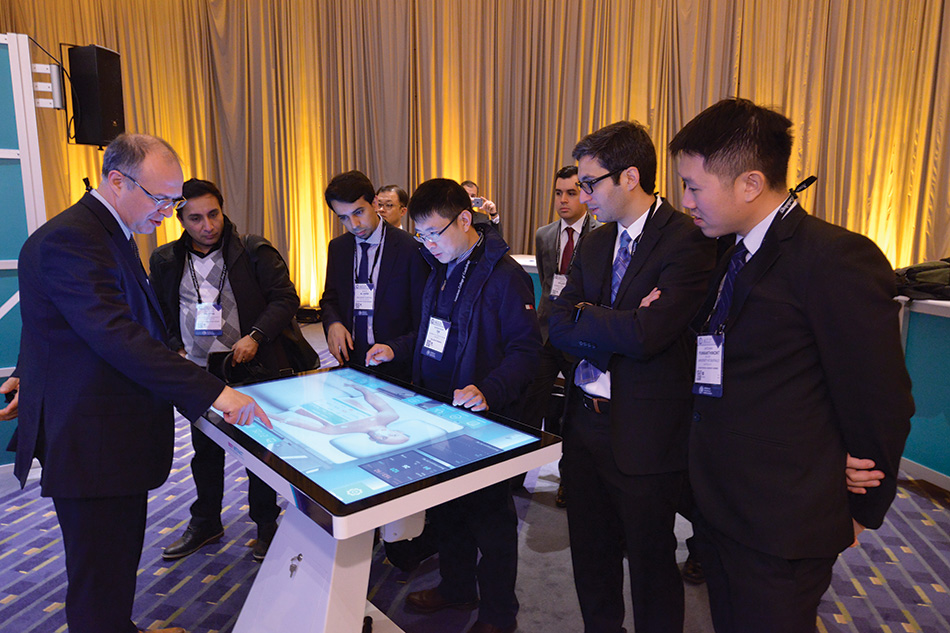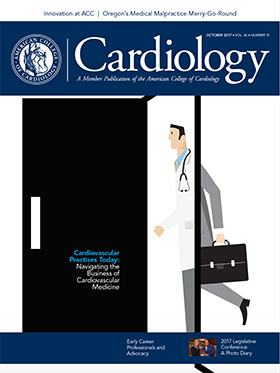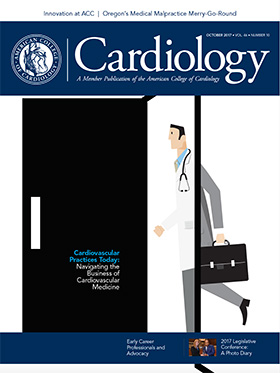Simulation-Based Education: Practice Makes Perfect

Practice makes perfect. The newer version of this age-old axiom is practice until you can’t get it wrong. Simulation is one approach that can make this happen. As simulation technology becomes increasingly sophisticated and numerous, the ACC’s Simulation Work Group is exploring how to maximize the value and quality of simulation-based education that could be provided by the College.
Established by the Lifelong Learning Oversight Committee (LLOC), the Work Group is working with staff in ACC’s Education Division as it examines program models and curriculum development to serve the membership. The Simulation Center at the ACC’s Annual Scientific Session has received positive feedback from members about their experience and has set the stage for extending this education.
“This effort is grounded in the principles of education and the College’s high-quality content,” says Matthew Martinez, MD, FACC, co-chair of the Work Group. A key mission of the ACC has always been ensuring that its membership is highly educated and state-of-the-art and “simulation is another facet of how this could be achieved,” adds Martinez.
Simulation can provide opportunities to practice clinical reasoning and judgement, communication and team work and technical skills, as well as build mental muscles and models. “A learner can be immersed in a case and learn from the decisions that are made, without a negative consequence for a real patient,” says Michael T. Spooner, MD, FACC, co-chair of the Work Group. In this controlled environment, learners receive feedback “that allows them to build a framework for understanding the information that’s most clinically relevant,” Spooner adds. Distinguishing the most relevant information is a challenge within the daily stream of information pouring in to every physician, he notes.
"A learner can be immersed in a case and learn from the decisions that are made, without a negative consequence for a real patient." — Michael T. Spooner, MD, FACC
Competency-based learning also can be provided through simulation, which could prove to be an important avenue because of the requirement of the American Board of Internal Medicine for physicians to demonstrate proficiency in technical skills starting in 2020.
ACC guideline-directed simulation-based education is one vision being explored by the Work Group. This approach capitalizes on the recognized high-quality content from the College. And it serves the new learner such as trainees, fellows and early career professionals transitioning from education to actual practice, as well as experienced professionals seeking to maintain high skill levels and gain new knowledge. This summer, during a meeting at Heart House, the Work Group demonstrated its first pilot initiative, which employs the heart failure guidelines in virtual cases of patients with heart failure, to the LLOC.
“Heart failure is a good model to showcase all the potential tools in simulation,” says Martinez. Heart failure is a very common part of everyone’s practice in cardiovascular medicine, whether in academic or private practice, and regardless of discipline, including clinicians and proceduralists. “We can disseminate state-of-the-art information across the spectrum from the physical exam to medical therapy, to advanced oral and intravenous therapies in the acute and chronic setting, and in complex advanced heart failure, including device therapy and transplantation,” he adds.
Representatives from four companies in the simulation space looking to partner with a professional society with evidence-based content were on hand at the meeting to demonstrate how their respective products could help improve heart failure-related skills or enhance scenario training. Task trainers were demonstrated by 3D Systems and a virtual reality approach to skills training was demonstrated by Arch Virtual. These task training products also can be incorporated into scenario training, such as the full-body mannequin from Laerdal or virtual patients from Body Interact.
Well-known to ACC members through the Simulation Center at the annual meeting, Body Interact is a clinical virtual simulator that provides a realistic interactive experience with 3-dimensional virtual patients. The dynamic scenarios mimic real-life with the patient’s symptoms evolving over time, requiring action, and each of the learner’s actions affecting the next step. A learner can access scenarios for solo learning on their computer or tablet. The large tabletop interface allows for a content expert to provide feedback during the experience and for team interaction that promotes and reinforces cooperation, coordination and communication. “The goal is to improve performance for delivering guideline-based treatment,” says Pedro Pinto, chief executive officer of Take the Wind, the developer of Body Interact.
Similarly, problem solving and clinical reasoning in an interdisciplinary, learner-centered environment is gained through training with SimMan 3G, the high-fidelity mannequin from Laerdal Medical Corp. The SimMan 3G heart failure scenario also included cardiac catheterization by incorporating the Mentice endovascular training module. “Such training provides experiential memory to draw on when treating a real patient,” says Robert Rupert, program manager, Business Development, Laerdal. A subject matter expert engages with the learner and provides feedback during and after the scenario, while an operator runs the console for the mannequin.
Task trainers, such as the Ultrasound (U/S) Mentor and the ANGIO Mentor from 3D Systems/Simbionix, provide learners the opportunity to develop psychomotor skills, and to refine cognitive skills through guideline-based procedural practice. The U/S Mentor, which has a transesophageal echocardiography module, and the ANGIO Mentor can be used separately or together and they can be integrated within a full-body mannequin with various cardiac catheterization options. Team training is possible with the ANGIO Mentor and this simultaneous involvement “can help the team members to refine processes and roles, along with refining knowledge and skill,” says Gilat Noiman, senior product manager, Healthcare at 3D Systems.
The simulators from 3D Systems include a customizable learning management system – MentorLearn – that collects performance data for each learner to track outcomes and proficiency. “The society can set the proficiency standards and benchmarks for each aspect of the training, and the learner receives metrics reports for their benchmarks and learning curve against those standards. Thus, the individual progress towards proficiency can be demonstrated and objectively assessed,” says Noiman.
"Simulation-based education is an opportunity to engage each member at their level of need." — Matthew Martinez, MD, FACC
Virtual reality and its potential for teaching procedures and surgery was demonstrated by Arch Virtual. “Clinical reasoning and decision-making that meets guideline-directed recommendations is also taught through our system,” says Jon Brouchoud, founder of Arch Virtual, which is already collaborating with partners in the medical space, like GE Healthcare. Using the Oculus Rift technology, a learner enters an immersive, holistic experience of being in an operating room and performing the procedure, including picking up instruments in the same manner as in a real operating room. A content expert can interact with the learner during the scenario they developed for Envision EMI.
Overall, “simulation-based education is an opportunity to engage each member at their level of need,” says Martinez. This could be initial learning of the material, returning to the material to ensure understanding and gaining mastery over time through repetition. Spooner adds that “active learning has greater stickiness, with a longer duration of knowledge retention.” Additionally, it can be available whenever and wherever the learner has time to engage, even if that’s just thirty minutes using a smartphone or laptop.
In addition to providing guideline-based education for individual ACC members and for interprofessional team training, the Simulation Work Group envisions working with existing platforms. This could include existing brick-and-mortar simulation centers and formal academic programs such as for Fellows in Training, residents or schools of nursing.
Tweet this article: Tweet
 |
|
| Click the cover image above to read the latest issue of Cardiology in e-pub format or click here to read it on the web! | |
Keywords: ACC Publications, Cardiology Magazine, Manikins, Problem-Based Learning, Operating Rooms, Learning Curve, Echocardiography, Transesophageal, Mentors, Benchmarking, Goals, Problem Solving, Decision Making, Fellowships and Scholarships, Memory, Private Practice, Heart Failure, Cardiac Catheterization, Environment, Controlled, Cognition
< Back to Listings


